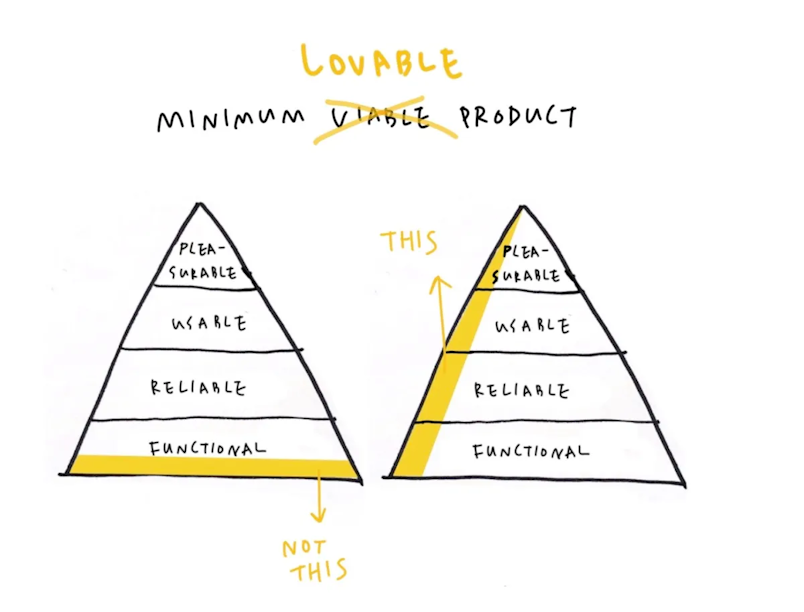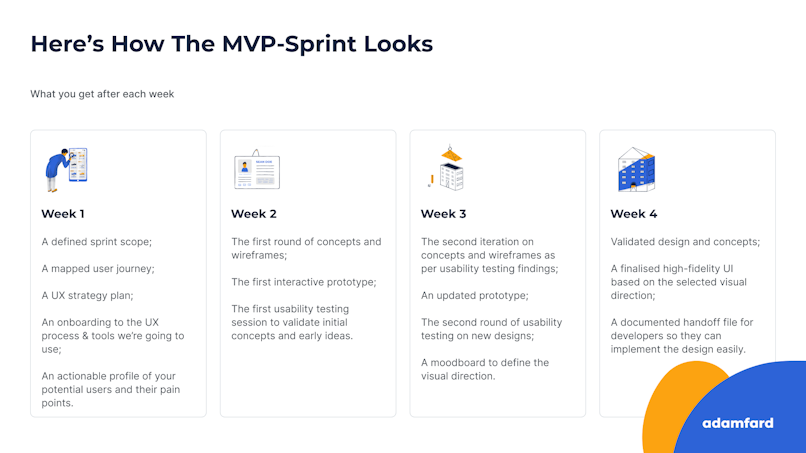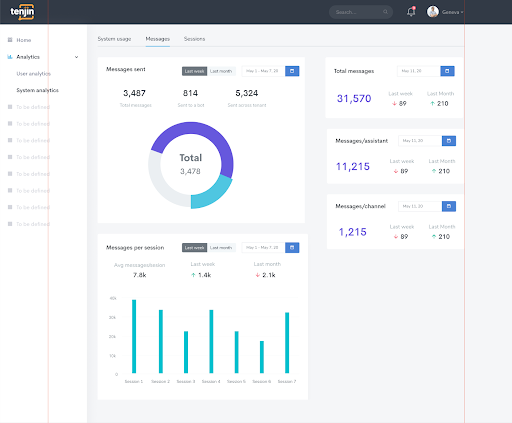In this article, we'll explore the concepts of Minimum Viable Product (MVP) and Minimum Lovable Product (MLP) in the context of product development. We'll delve into their definitions, and differences, and guide you in deciding which approach aligns best with your project's goals and constraints.
What's MVP?
MVP (Minimum Viable Product), as the name suggests, embodies the idea of creating the most basic version of your product that can still address the core problem or need of your target audience. The primary goal of an MVP is to test your product idea quickly and cost-effectively, gathering valuable user feedback in the process.
What's MLP?
On the other hand, MLP (Minimum Lovable Product) takes a user-centric approach that extends beyond mere functionality. An MLP aims to create a product that not only fulfills user needs but also captivates users emotionally through exceptional design and user experience.
The minimum lovable product is often viewed in opposition to an MVP. The typical infographics look something like this:

MVP vs. MLP
It would be best if we summarized the differences in the table here.
| Aspect | MVP | MLP |
|---|---|---|
| Definition | MVP focuses on essential features | MLP prioritizes user experience and design |
| User Experience | Functional but basic | Exceptional and emotionally engaging |
| Design | Often minimalistic | High attention to aesthetics and usability |
| Time to Market | Quick launch with core features | Longer development time for refinement |
| Market Validation | Rapid validation of basic concept | Building a loyal user base |
| Risk Management | Mitigates risk through early feedback | Higher investment with potentially greater rewards |
How to Build an MVP
Here are a few practical steps you can take to develop an MVP.
Identify Your Target Audience: Begin by defining your target audience and creating user personas. Understand their pain points and needs.
Define the Core Problem: Clearly articulate the core problem your product aims to solve. This forms the foundation of your MVP.
Determine Essential Features: Identify the minimal set of features required to address the core problem. Avoid feature bloat.
Build a Functional Prototype: Create a functional prototype or the minimum version of your product that includes these essential features.
User Testing and Iteration: Launch your MVP to a select group of users for testing. Gather feedback and iterate based on their insights.
In our agency, we adhere to the following process:

How to Build an MLP
Practical Steps for Building an MLP:
User Research: Conduct comprehensive user research to understand user preferences, emotions, and aspirations.
Design Prototypes: Develop design prototypes that focus on aesthetics, usability, and an intuitive user experience.
Gather Feedback: Continuously gather user feedback throughout the design and development process.
Emotional Engagement: Create user-centric experiences that evoke positive emotions and foster a deep connection with your product.
How Do You Decide Which?
Choosing between MVP and MLP hinges on several factors:
Project Goals: Consider your objectives. Are you looking to quickly validate an idea (MVP) or create a product with a strong emotional connection (MLP)?
Target Audience: Understand your audience's expectations. Do they prioritize functionality or are they swayed by aesthetics and user experience?
Resources: Assess your available resources in terms of time, budget, and talent. MVPs are typically less labor-intensive than MLPs.
Competition: Evaluate the competitive landscape. Will exceptional design and user experience set you apart? If not, an MVP might be a better idea.
Beyond MVP and MLP
Most times, choosing between MVP and MLP during product development requires a more nuanced approach. Let's consider ways to balance both processes.
Hybrid Models: A Middle Ground
While MVPs and MLPs offer distinct approaches, there's a middle ground that combines the best of both worlds. A hybrid model allows you to launch a product with core features quickly, while continuously iterating and enhancing the user experience.
Imagine launching a minimal version of your product with basic functionality. Once it's in the hands of users, you can gather valuable feedback and use it to iterate on the design and features. This approach balances the speed of an MVP with the user-centric focus of an MLP.
A great example of a hybrid model is how Dropbox launched. They started with a simple file-sharing service and added features like file synchronization and collaboration later on.
Iterative Development: A Continuous Journey
Dropbox evolved into a powerful productivity tool by iterating based on user feedback.
Iterative development is the heart of successful product development. It involves building a product in cycles, gathering feedback at each stage, and making improvements based on insights. This approach allows you to adapt to changing market dynamics and user needs.
Image.
Agile methodologies, such as Scrum and Kanban, are well-suited for iterative development. These frameworks prioritize flexibility, collaboration, and continuous delivery.
Agile teams can quickly respond to changes and deliver value to users because they break down the development process into smaller, manageable sprints.
User-Centric Design: Putting People First
User-centric design is all about putting the user at the center of the development process. To create products that meet user expectations, you must understand their needs and pain points.
A good way to ensure this is user testing.
User testing is a crucial component of user-centric design that involves observing how users interact with your product. This can help you identify usability issues, gather feedback, and make informed design decisions.
By actively seeking and incorporating user feedback, you can create products that evolve and adapt to changing user needs.
The Role of Metrics: Data-Driven Decision Making
UX metrics are the lifeblood of data-driven product development. Tracking key metrics will expose valuable insights into user behavior, product performance, and the overall impact of your product.
For MVPs, focus on metrics that measure user acquisition, activation, and retention.
Key metrics might include:
User acquisition: Number of sign-ups, downloads, or installs
User activation: Percentage of users who complete a core action (e.g., making a purchase, sharing a post)
User retention: Percentage of users who return to the product over time
For MLPs, metrics should focus on user satisfaction, engagement, and loyalty.
Key metrics might include:
User satisfaction: Net Promoter Score (NPS), customer satisfaction scores
User engagement: Time spent on the product, frequency of use, number of interactions
User loyalty: Customer lifetime value, churn rate
Remember, data is a powerful tool, but it's important to use it wisely. You can make data-driven decisions about product features, marketing strategies, and overall product direction by analyzing these metrics.
Case Study
The Tenjin Project: A Data-Driven Approach to Reimagining Request Management
Biomni's Tenjin project aimed to revolutionize traditional request management systems. By adopting a sound MVP approach, we prioritized core functionalities such as basic chatbot capabilities, core request management features, and integration with existing systems. This allowed us to quickly deliver a valuable product and gather crucial user feedback.
Through iterative development, we enhanced Tenjin with advanced features like natural language processing, knowledge base integration, and gamification elements. By continuously analyzing user data, we were able to optimize the product and deliver a seamless user experience.
Key Impacts and Outcomes:
Improved Efficiency: Streamlined workflows and reduced response times.
Enhanced User Experience: Intuitive interface and personalized interactions.
Increased Productivity: Automated routine tasks and empowered users to focus on strategic work.
Data-Driven Decision Making: Informed product decisions based on user behavior and analytics.
Successful Product Launch: A timely and well-received product launch that met user needs.

Do you need help creating an MVP or MLP? Book a free consultation with our experts today to discuss your needs.
Conclusion
In conclusion, the choice between MVP and MLP depends on your project's specific goals, resources, and timelines.
Whether you opt for the pragmatic approach of MVP or the user-centric approach of MLP, the ultimate goal remains consistent: delivering value to your users and achieving success in the market.
By considering the factors discussed in this article, you'll be better prepared to make an informed decision and set your product development journey on the right path.
What is the main difference between an MVP and an MLP?
An MVP, or Minimum Viable Product, is a basic version of a product with minimal features. It's designed to test the market and gather user feedback. An MLP, or Minimum Lovable Product, goes beyond functionality and focuses on creating a delightful user experience. It aims to captivate users and build a loyal following.
When should I choose an MVP over an MLP?
Choose an MVP when you need to validate a product idea quickly and minimize risk. If you have a clear understanding of your target market and their needs, an MLP can help you create a more compelling product.
How can I balance the speed of an MVP with the quality of an MLP?
A hybrid approach can be effective. Start with a minimal viable product to validate your core idea and gather user feedback. Then, iterate on the design and features to enhance the user experience and create a more lovable product.
What role does data play in MVP and MLP development?
Data is crucial in both approaches. For MVPs, data can be used to identify key metrics and track user behavior. For MLPs, data can be used to understand user emotions, preferences, and motivations. By using data to inform your decisions, you can create products that resonate with your target audience.





